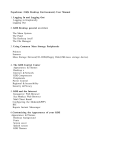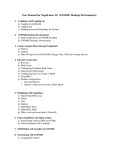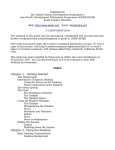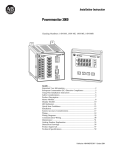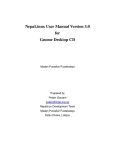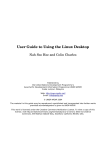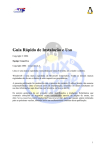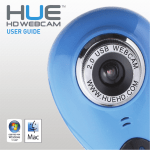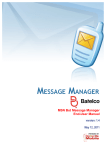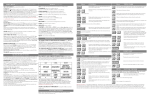Download NepaLinux 3.0(K Desktop Environment) User Manual 1. Logging In
Transcript
NepaLinux 3.0(K Desktop Environment) User Manual 1. Logging In and Logging Out Logging in Graphically Logging Out 2. KDE Desktop general overview The Menu System The Panel The Desktop itself The File Manager 3. Using Common Mass Storage Peripherals Printers Scanner Mass Storage Devices(CDROM,Floppy Disk,USB mass storage device) 4. The KDE Control Center Appearance & Themes Desktop s Internet & Network KDE Components Peripherals Power Control Regional & Accessibility Security & Privacy 5. KDE and the Internet Konqueror Web Browser Sea Monkey Web Browser Mail Client Kmail Configuring the Modem(KPPP) IRC Kopete Instant Messenger 6.Customizing the Appearance of your KDE Appearance & Themes Desktop background Fonts Screen saver Splash screen KDE Themes 7.Publishing with KDE KDE editors Kedit Nepali OpenOffice.org Writer Calc Impress OpenOffice Draw OpenOffice Math 8. Fonts installation and Input system Nepali Input system (XKB and SCIM) Fonts Installation (GUI method) 9. MultiMedia and Graphics in KDE 10. Networking with KDE Assigning IP address File Sharing Wireless Card configuration using Ndiswrapper 1. Logging in and Logging out Logging in Graphically: During the time of NepaLinux Installation, users are asked to create at least one user account. Users must provide this username and the corresponding password to be able to login into the system. the root user is generally not used to login into system because of the security reasons. When users login for the first time users are asked to which language they want their Desktop environment, once you set this language it remain as it is. To switch the language for example to Nepali environment, you have to go through KDE control center. For details about it please refer to the section “control section”. Logging out: Click on the Main menu and click on Log out. User can also select between the options to Turning off , restarting and logging out. 2. KDE Desktop general overview: KDE is a network transparent contemporary desktop environment for UNIX workstations. KDE seeks to fill the need for an easy to use desktop for Unix workstations, similar to the desktop environment under MacOS and Windows environment. NepaLinux 3.0 KDE consists of koffice suite for office productivity, Konqueror for file and web Browser, KPPP for configuring Modem and Kmail for mail client. Apart from these it includes several other utilities for Multimedia, Graphics, education and games. Main components of Desktop There are three main components on the KDE Desktop. * The Menu * The Panel * The Desktop itself The Menu System The main Menu can be accessed by clicking on the Main Menu button located at the extreme lower left hand corner of the Desktop. The Menu may be protrayed by one of several icons depending upon the Desktop environmet used. Fig. Generic KDE main Menu button. Clicking on this will bring up the menu system as shown. From Menu system we can start any of the programs installed in our NepaLinux system. Note that Menu system consists of main Menu Panel and sub Menu Panel. Each entry in the Menu System which has an arrow on its right means that it is an entry point to a submenu, and there can be submenus within each submenu. The Panel The long bar across the bottom of the desktop screen is called the Panel. The Panel contains the Main Menu icon, the application launcher icons, a notification area and applets. Applets Applets are small applications that run on the Panel. You can add the Applet to the Panel by right clicking the panel and selecting "add applet to the panel". For example to add the Show Desktop applet to the Panel select the Show applet in the applet menu. The Desktop The Desktop space refers to the rest of the screen. The File Manager: KDE includes very versatile and powerful file manager called Konqueror which allow you to do everything with the files stored in the computer. If you want more details about what Konqueror take a look at the Konqueror Handbook by selecting Help>Konqueror Handbook in the Konqueror menus; or, alternatively, you can use the help in Konqueror by entering help:/konqueror in the Location Toolbar. Folders: You can open any item by clicking just once on the icon for the file.(since KDE doesn't use double clicking in its default settings).Folder will be opend in the same window or in the appropriate program. You can go back to the last folder by clicking on the Back button or go up by clicking the up icon. The Navigation Panel (aka The Sidebar) Fig. The Konqueror sidebar Navigating through the folders by using the folder view can become impractical. The sidebar provides shortcuts and special functions that make it easier to find what you are searching for. On the left edge of the sidebar you will find a number of buttons, each with a different icon. Bookmarks As Konqueror (the file manager) also serves as a very powerful web browser, it also has a bookmark functionality. Here you will find the same structure as in your Bookmarks menu. History Konqueror will remember the web pages you have visited and list them either by date or alphabetically in a tree structure Home Folder The Home Directory item is in the sidebar's navigation panel. You will find your home directory as the first entry. Root Folder Everything on a UNIX based system is organized in a file system tree. The Root Folder function is like the Home Folder function. The only difference is that every folder is being displayed, not only your home directory. Network Here you can browse the services provided by other computers on the network. The network browser allows you to see a variety of services provided by a computer. You can easily browse SMB shares, HTTP sites. The Trash The file is moved to the Trash folder when you delete the file before it is permanently removed, so that there is possibility of getting it back if you deleted it by accident. For restoring the file select the file and move it to the original place. If you right click in the Trash bin and select Empty Trash Bin, then the files will be deleted permanently. References: KDE online Manual http://docs.kde.org/development/en/kdebase/userguide/index.html 3.Using common Mass storage The more common peripherals include: Printer Scanner Mass storage devices We shall be looking at how to access and use the common peripheral mass storage devices, Floppy disk drive CDROM drive USB mass storage device CDRW drive Printer Setup: If you have a printer attached to your system you will need to configure and set it up before you can use it properly. To do this, 1.KDE Menu > Control Center > Peripherals > printers 2.Now click on Administrator mode (You are asked to enter the root password) 3. At the printer configuration screen click on the Add > Add Printer/Class menu to add and configure a new printer. 4. The add new printer wizard will be displayed. 5. Select the local printer or Network printer. 6. select how your computer is connected to the printer (the 'port'). 7. Once you select the port , click Next. 8. Select the manufacturer of your printer, and then your specific printer from right side. 9. Then click Next. Network Printer: 1.Select network printer and click Next. 2. Provide the URL for the path. 3. Select the proper manufacturer and the Model for the Printer. 4. Click Next and provide the other required information such as printers name, location etc. Mass Storage Device: USB Mass storage device Another popular portable storage medium is the USB mass storage device. (Flash Drives) As soon as you enter your USB disk this pop up menu appear. You can click Open in New Window and browse you USB disk. To safely remove your USB disk, click System > Storage Media > right click USB drive icon and click safely remove. As of USB Disk , when you enter CDROM, or DVDROM it will be automatically detected and pop up menu appear in your Desktop. Similarly you can access the Floppy Drive from the System> Storage Media > Floppy Disk. CD/DVD Burner (K3B) K3b is a CD and DVD burning application which provides a comfortable user interface to perform most CD/DVD burning tasks like creating an Audio CD from a set of audio files , copying a CD or DVD, Making data CD or DVD and writing ISO. To use this k3b, start the K3b program from the Main Menu. Main Menu > Multimedia > K3b 4. The KDE Control Center It is a place where you can change any settings that affect the whole of your KDE environment. You can open it from the using the Control Center item in the K menu. The settings are divided into several major categories, which each contain several pages of settings. To display a settings page, expand the major category by clicking on the + button next to it, and then click on the name of the page you want. The settings page then appears on the right, and you can change settings to your heart's content. No changes take effect until you click on the Apply button. If you decide, after making some changes, that you want to leave the settings as they were, just click on Reset. Appearance & Themes Here you will find settings that change the way your KDE desktop and applications look. In this section you can change background, colors ,fonts, Icons, style, themes etc. Desktop This is where you will find settings to configure the appearance and behavior of your KDE desktop. Here you can change behavior, multiple desktop setting, panels,taskbar etc. Internet and Network Here you can set the setting for Internet and Network, such as IP assignment, File sharing etc. The detail in this setting will be covered in the “Networking with KDE “section. KDE Components In this section you can modify advance KDE options such as file associations and default applications. For example in the file composer section you can define what Email Client, Embedded Text Editor, Instant Messenger, Terminal Emulator and Web Browser to use. Peripherals you can change setting related to peripherals such as keyboard, mouse , display printers etc. for example you can change the display setting through this section in the control center. Power control This section has a single module, Laptop Battery. Here you can configure the appearance and behavior of the Klaptopdaemon battery monitor. You can select battery icons to represent different power states, and set up notification of certain events. In the case that your battery runs down to a critical level, you can configure the daemon to suspend or shutdown your laptop, to save you from losing data. Regional & Accessibility This section is where you can configure options to do with region and locale. You can switch your login environment to another language from this section for example Nepali to English and vice versa. To change the login environment to English click add language tab and select English, then move it up to make it default. Your setting will take place next time you login. In this section you can also configure keyboard layout. The detail about the keyboard layout is explained under the section “Font Installation and Keyboard Layout” Security & Privacy This section is where you can configure options related to security and privacy such as the use of cryptography, setting your identity and managing caches. System Administration As the name implies this contains the section to configure administrative tasks such as installing fonts, login manager, and Date and Time. 5.KDE and the Internet Konqueror Konqueror is not just a web browser but is also an advanced File Manager and Universal viewing application. Konqueror as a File Manager: Konqueror is an advanced file manger for the K Desktop Environment, providing the file management functions ranging from simple cut/copy paste operations to advanced local and remote network file browsing. File and folder properties can easily be examined and changed and application lunched with a simple click of the left mouse button. Konqueror as a web browser: Konqueror is an excellent web browser with built in support for JavaScript , CSS, bidirectional scripts. Konqueror is also an excellent full featured FTP client. Note: Konqueror by default does not support the gmail standard view. To support the standard view, follow the following steps Konqueror > Settings > Configure Konqueror > Browser Identification Click on New... and add mail.google.com and select identification Firefox 1.0.7 Konqueror as application viewer: Konqueror is also a universal viewing application, capable of displaying images and documents without having to launch another application. Seamonkey Web Browser KDE also includes seaMonkey web Browser. KDE Menu > Internet > SeaMonkey Web Browser. Mail Client Kmail: KMail is a mail client. With Kmail you can browse your mail online or you can download your mail and read it offline. Follow the steps below to setup Kmail. 1. Open KDE Menu > Internet > Mail Client (KMail) 2. Select POP3 or IMAP in the Account Type 3. Provide your full name email id and organization Name 4. Provide your full email address in the login name field and provide password. 5. Provide POP3 server name. It is the name of the server where your mails will be collected 6. Provide SMTP server name. It is the name of the server through which your mail will be sent out. Get this name from your ISP. 7. And click on finish. Instant Messanger (Kopete) Kopete is an instant messenger supporting AIM, ICQ, MSN, Yahoo, Jabber, IRC, GaduGadu, Novell GroupWise Messenger, and more. 1. Run Kopete from KDE Menu > Instant Messenger (Kopete) 2. Now select the proper protocol for instant messaging depending upon your mail ID .for example if your mail ID is of yahoo, select the yahoo protocol. 3. Provide the valid user ID and password. 4. Now click Next. Then after you are connected you are presented with your friends list. IRC Client KDE has its own IRC client called Ksirc. 1. Run it from KDE Menu > Internet > IRC Client (IRC) 2. To connect to the required channel click connect > New server 3. Then select the proper Groups of the channel, Freenode is the best channel for free and open source software and other Linux related support. NepaLinux also has its IRC channel in the freenode. Now to join the channel type /join #<channel name > for example to join the Nepalinux IRC channel, / join #nepalinux. Configuring the Modem (KPPP) : To configure your modem for Internet access, start the “Internet Configuration Wizard” tool from the Main Menu: Kde Main menu > Internet > Internel DialUp Tool (KPPP): 6. Customizing the Appearance of your KDE Appearance and Themes The appearance of KDE can be customized in different ways. It can either be done by changing the theme or by changing the different components like desktop background, icons, etc. Desktop Background The desktop background, which is also known as wallpaper, can be changed either by going to the Control Center or by rightclicking on the desktop. First Method: Go to Kmenu and click on the Control Center On the 'Appearance and Themes', choose Background Second Method: Rightclick on the desktop background Choose 'Configure Desktop' Both of these methods will take you to the same point from where you can change the desktop background. Fig. Changing the background image To change the desktop background, Click on the radio button marked 'Picture' Choose from the dropdown list If you want to choose any other image of your choice apart from the ones shown in the list, click the 'Open dialog file' button on the side of the dropdown list After choosing an image, click 'Apply' and 'OK' Fonts The fonts used to display on different places like Toolbar, Menu, Window title, Taskbar, Desktop, etc. can be changed as per user's choice. Fig. Changing the display fonts To change the fonts, Go to K menu and click on the Control Center On the 'Appearance and Themes', choose 'Fonts' Click 'Choose' to choose from the list of fonts and then select their style and size After choosing a font, click 'OK' and then 'Apply' Screen Saver Screen saver is the animated screen that is displayed after certain period of time when the user remains idle. Fig. Changing the Screen Saver To change the screen saver, Go to K menu and click on the Control Center On the 'Appearance and Themes', choose 'Screen Saver' Choose from the list of screen savers After choosing the screen saver, click 'Apply' Splash Screen Splash screen is the animated screen that is displayed after a user successfully logs in to the system using any of the graphical user environments (GUI). What is to be kept in mind is that each user can have a different splash screen as per the user's choice. So whenever a user changes the splash screen, if takes effect only for that particular user and does not affect the settings of the others. Fig. The default KDE splash screen being displayed To change the splash screen, Go to K menu and click on the Control Center On the 'Appearance and Themes', choose 'Splash Screen' Choose the splash screen of your choice from the list; you can even test the splash screen After choosing a splash screen, click 'Apply' KDE Theme Changing the theme of KDE affects many aspects of one's desktop. For example, background, color, style, icons, fonts, screen saver, etc. A theme can either be chosen from the list of available themes or a new theme can be installed from outside. The other option is to customize different components of the appearance and create a new theme of one's own choice. Fig. Changing the KDE theme To change the KDE theme, Go to K menu and click on the Control Center On the 'Appearance and Themes', choose 'Theme Manager' Choose the theme of your choice from the list After choosing a theme, click 'Apply' Similarly, to install a new theme from outside, click on 'Install New Theme' and choose the theme file. The other option, as we mentioned above, is to customize different components like background, colors, etc. After customizing different components, click on 'Create a New Theme', enter the required information and click 'OK. Your newly created theme will be added to the list of available themes, from where you can choose your theme. References http://docs.kde.org/development/en/kdebase/userguide/index.html 7. Publishing with KDE Text Editor in KDE KEdit, KWrite, Kate are some of the text editors available in KDE. Although a fullfledged word processor like OpenOffice.org Writer is available, users can use simple text editors like the ones mentioned above for simple text editing. In this section, we shall look at using one of the text editors in KDE Desktop – KWrite. Note: A text file simply refers to a file which contains pure text printing characters only. To start KWrite, Go to K menu Click Utilities > Editors > KWrite Fig. Kwrite text editor in KDE The users can simply type in the KWrite window after the KWrite has started. Both the mouse and keyboard can be used to move around in the KWrite window. The text can be deleted one character at a time by using the DELETE /BACKSPACE key or by selecting the text to be deleted and then pressing the DELETE key to delete a block of text. To copy, cut and paste the text, select a block of text. Then click on the Edit option on the top menu bar and select as required. Like, Edit > Cut Edit > Copy Edit > Paste Similarly, the Undo button on the Edit option can be used to undo the latest changes. To save the text typed, click on the Save As button on the File option on the main menu as, File > Save As... Go to the folder where you want to save the file and then give the name of the file. In order to find a text string in the file, the Find button can be used on the Edit menu. Similarly, the Replace button can be used to find a text string and replace it with another one. An already saved file on the system can be opened by clicking on the Open button on the File on the main menu as, File > Open and by selecting the file to open. To change the preferences like fonts, colors, etc., go to: Settings > Configure Editor For more information on how to use KWrite can be obtained by selecting Help from the menu at the top. References http://www.iosn.net/training/endusermanual/linuxuserguidekde.odt Nepali OpenOffice.org Nepali OpenOffice.org (OOo) is a complete office suite in Nepali, featuring a word processor (Writer), a spreadsheet application (Calc), and presentation software (Impress). Besides these fundamental office applications, OOo also includes a vector drawing tool (Draw), database access program, publication of documents in the Portable Document Format (PDF) and presentations in the Flash (SWF) format! The OOo package is fully interoperable with the Microsoft Office suite. Using OpenOffice.org As a first step for information, it is important to know how the Help system works. To get help: Help > Contents Pay attention to the Options (where you can get help for the individual components in OpenOffice.org). Setting up OpenOffice.org preferences makes it work the way you want it . The entire controls for this are available at: Tools > Options For opening the document whatever you saved in the openOffice.org using the MicroSoft Office package, always save it in the respective format of the Microsoft package. For eg. For word file .doc format , for excel .xls and for powerpoint .ppt. WRITER This is a powerful tool for creating professional documents, reports, newsletters and so on – it is a word processor that allows easy integration of charts and pictures, as well as other OpenOffice.org compatible documents. It can create anything from a simple letter to books, with professional layouts, making use of styles. Start it from the Main Menu by, Applications > Office > OpenOffice.org Writer Common Functions Functions of the word processor can be controlled via the toolbars located at the top of the screen. On the first row, file actions like opening and saving can be performed, while on the second row, changing the font, size, and style (bold, underline, or italics) are located. They can also be controlled by the menus that are common through packages: * File > New > Text Document Creates a new empty, untitled document for you to work on. * File > Open Opens the file. * File > Close Closes the document you are working on. If changes have been made since your last save, you will be prompted to save or discard those changes. * File > Save Saves the document you are currently working on. * File > Save As... Saves an updated version of a document in a different location, with a different name, from the previously saved version. Common Operations * To copy text: Select the text with the mouse, then select Edit > Copy. The selected text is kept in memory for use elsewhere. * To paste text: Find the spot where the text needs to be placed, place the cursor there, and then select Edit > Paste. * To cut text: This means that the selected text will be removed from the current location and kept in memory, to be placed elsewhere. Doing this is exactly like how a copy should be performed, except selecting Edit > Cut instead. * To undo an action: Select Edit > Undo. It will display the command that it is undoing at the moment. By browsing the menu, there are also keyboard shortcuts located next to it. Once more proficient use of the package occurs, it is much quicker to use keyboard shortcuts like Control+C for Copy, and so on. Formatting Some of the quick formatting options are bold, italics and underline. These options are available at the toolbar at the top of the screen. Text alignment plays a large role in controlling how portions of the document will look. For example, an address field at the top of your letter will have such details rightaligned, while the body and rest of the base text will be leftaligned. There are fouricons that are located next to the bold/italics/underline icons, providing options such as: rightalign, centrealign, leftalign and justified. You can also highlight text and/or its background (like you would with a highlighter and paper!), and change the font and/or background colours all with the icons there. Fonts Changing the font, size, and style (bold, underline, or italics) are located in the second row. This can be done by highlighting the desired text and clicking the appropriate button. Others Writer has a builtin spell checker. This can be accessed via: Tools > Spellcheck The option to autospellcheck means that while typing, Writer will dynamically check your spelling, and if it detects an error, it will output a redline at the bottom of the misspelled word. Keep in mind that the spell checking is based on the current language that is in use. This can be changed via: Tools > Options > Language Settings > Languages Nepali Thesaurus can be found by highlighting the word and pressing Ctrl+F7 key. Accessing word counts in the document is different to most other packages on a default installation of OpenOffice.org (this can differ with several Linux distributions' offerings): File > Properties > Statistics It is under the Statistics tab that the word counts and other relevant document counts are based. On certain vendor modified distributions of OpenOffice.org, going to the Tools > Word Count menu will allow the Statistics dialogue box to be displayed automatically. CALC This is the spreadsheet component of the OpenOffice.org package, and contains many useful features, including an array of functions and plenty of charting options. It is fully interoperable with Microsoft Excel, though the function separators differ in the two packages. CALC may be run opting for Applications > Office > OpenOffice.org Calc or if you already have an existing window of OpenOffice.org open, File > New > Spreadsheet. Spreadsheets contain many rows and columns, and each row and column combination is called a cell (like A1, B4, and so on). Upon inputting text into a cell, you might realize that the text is wider than the cell allows – this can be resized via rightclicking the cell, and selecting the Format Cells option. Then under the Alignment tab, selecting Line Break is what is required. Formatting If there is some information that has already been created, and the area should be formatted, one particular quick and easy option would be to use the AutoFormats available in Calc. This is done after selecting the area and then opting for: Format > AutoFormat These are predefined styles that are available in Calc, and if you have created your own particular style, you can add them into your new AutoFormats. In the object toolbar, there is an option to set the font colour within the cell. There are also options to increase/decrease the indents within a cell, and in the image below, controls for enabling: • Currency • Percentage • Add/Remove significant decimal places These are quick controls, and accessing them is as simple as clicking the icons that represent them, and automatically the cell will be formatted as stated. Not only can the borders be set easily, and cell backgrounds too, but the alignment of text within a cell can also be set. This can be either as top aligned, centre aligned, or bottom aligned. Sorting A big part of dealing with spreadsheets involves a lot of sorting and filtering of data. To sort a dataset, selecting the active cells, then on clicking Data > Sort will call a popup dialogue that has options for sorting the data based on the columns present, as well as if the data should be ascending or descending. IMPRESS No office suite is complete without a presentation piece, and OpenOffice.org shows its colours with Impress, the presentation piece in the suite. To get started with IMPRESS you need to opt the following: Main Menu > Office > OpenOffice.org Impress or if you already have an OpenOffice.org window open, its available at File > New > Presentation Unlike other components of OpenOffice.org, when you start Impress, you are presented with an AutoPilot, to start creating your presentation! This gives you options to start a presentation with an empty template, or even with one of the predefined templates. A preview dialogue is available, and once all options are selected (and Next is clicked, to move on), you get a basic presentation. Views There are several views in Impress, and some have overlapping names, but with different functionality! Just above the scroll bars, you'll notice five buttons that look like what you see below. The five options for workspace views are: * Normal view – normal look of the presentation * Outline view – overlook of the presentation. * Notes view – add speaker notes. * Handout view – how handouts get printed. * Slide Sorter – birds eye view to add, change, switch slides around. All the views can also be accessed via: View > Workspace It is also worthwhile to note that at the bottomlefthandcorner of your screen, where the slide tabs are displayed, there are more views to know about. You are typically located in the Slide View (same name as above, but different functionality since its on a different bar!) However, Master Views are supported and to access this view, it is the second button from the left. You can have master views of all workspace views (i.e. a master view of the slide itself, notes, and handouts). The Layer view allows layering of slides (adding and removing), and layers can be non printing or nondisplayed on screen, but printing only. OpenOffice Draw – A drawing application that lets you add, edit, and align objects; incorporate textures; include textures and colors; and work with layers of objects. OpenOffice Math – A calculation program that lets you create mathematical formulas. Other Word Processors Other free word processors that come with NepaLinux include Abiword and Gedit. Ref. 1. http://www.iosn.net/training/endusermanual/print/linuxuserguideall.pdf 2. OpenOffice.org user guide 8. Fonts Installation and Input System Font Installation: Copy the font you want to install Open Konqueror and type "fonts:/System" in the address bar Now paste the file. You may be asked to supply root password. You might have to logout and login to see the effect. Alternatively, 1. KDE Menu>Control Center > System Administration > Font Installer 2. Click on Administrator mode and provide root password. 3. Click on Add Fonts, a new window will open , Browse the fonts you want to install.s Nepali Input System Adding Nepali Romanized Keyboard Layout KDE Main Menu > Control Center > Regional & Accessibility > Keyboard Layout In Layout Tab check "Enable keyboard layouts" Now from available layouts select Nepal and click on Add >> Now upon clicking on apply you will notice a layout being added right side of the bottom panel . Open any text editor and click on the newly added layout. It will switch to nepali Now you can input in Nepali. SCIM input system : In scim input system there are 2 keyboard layout for nepali input. Romanized and Traditional. Just open any text editor and hit ctrl+space. A small bar will pop up on the right bottom. Now you can choose between Romanized and Traditional layout by clicking and selecting. 9. Multimedia and Graphics in KDE Multimedia Listening to Audio It can be launched from KDE Menu>Multimedia > XMMS. XMMS may need additional plugins to be able to play some of the audio file formats. Audio Player (Amarok) KDE Menu >Multimedia > Audio Player (Amarok) Playing VCD and DVD VLC Media can be used to play both audio and video including VCD and DVD. You can access the VLC through, KDE Menu > Multimedia > VLC Media Player KDE Graphics Krita is a photo retouching, image editing application, but above all, a paint application that will allow you to create original art on your computer as if you were working with paint and brushes, pencils, pen and ink. KPDF An advanced PDF viewer, based on xpdf, for KDE. KPDF contains a number of ways to search through the document (standard find dialog, thumbnail filter, etc.) and has other features such as hands free reading. You can access it as, KDE Menu > Graphics > KPDF PDF Viewer KSnapshot An application for taking screenshots. It is capable of capturing images of the whole desktop, a single window, or a selected region. The images can then be saved in a variety of formats, including JPG and PNG. You can acces the KSnaspshot as, KDE Menu > Graphics > KSnapshot Screen Capture Program KView An image viewer program which supports a number of different image filetypes including JPEG, GIF, PNG, TIFF and many others. Kview has full integration with KDE and it can be embedded into Konqueror for viewing image files on your diskdrive as well as your FTP site or webserver, using its URL open support. Other features include a few image manipulations such as zoom, rotate, grayscale and flip. 10. Networking with KDE Assigning IP address KDE Menu >Control Center >Network Setting Click Administrator Mode button, you are asked to supply root password. Select the interface and click on Configure Interface button. Select the automatic or manual as of your requirement. For manual setting provide the IP address and subnet mask. You can add Broadcast address and gateway by clicking advance button. To provide the DNS address, click on Domain Name System tab and add the DNS address by clicking add button. File Sharing you can share files from one NepaLinux to another NepaLinux using either Samba or NFS(Network File System). Right Click on the folder that you want to share,then click on properties Click on the Share tab Click on Configure File Sharing Type the root password A new window will be shown. Click on Add Choose the folder that you want to share Check "Share with Samba (Microsoft(R) Windows(R))" Check Writable if you want other users to have write access to the folder otherwise you can leave it so that it will be readonly. Click Ok You have just shared your folder to other NepaLinux and Windows machines. Accessing Shared Folders Open the konqueror and type smb://<ip or hostname> You may have to provide user name and password depending on the types of share. You can acces the share alternatively as , Open the Konqueror. Click Network Folders. Click Samba Sharesss Choose the workgroup that you want to access. Wireless card configuration using Ndiswrapper(hard disk installation only) Ndiswrapper is a tool that emulates the windows wireless driver into the Linux system. So you don't have to worry about the Linux driver for the wireless card. It supports almost all of the wireless card ,but for these card you must have the driver for windows system. 1. Desktop> Administration > Windows wireless Tools 2. Now you are asked to enter the root password. 3. Enter the password and click OK. 4. Now click on the Install New Drive r. 5. Browse the proper .inf file for your wireless card. (Generally from the driver CD of your Laptop). 6.After you got the proper .inf file, click Install. 7. Now your wireless card is detected. You con configure it as usual as of other Ethernet card from the KDE Menu > Control panel >Internet and Network > Network setting References: 1. User Guide to Using the Linux Desktop.The United Nations Development Programme’s AsiaPacific Development Information Programme (UNDPAPDIP), Kuala Lumpur, Malaysia. 2. KDE User guide (docs.kde.org)











































